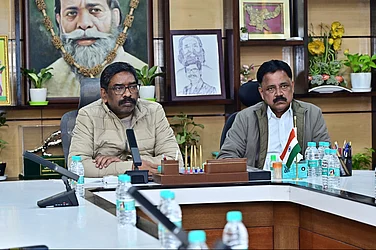“Parliament is like an all-male club and I feel like an unwanted intruder.” These words uttered by Trinamool Congress MP Krishna Bose on the floor of Parliament on March 9, 1999, not only reflected the angst of women, rather it also spoke of the exclusivity of the ‘House of the People’ as a ‘man’s house’. As the Women's Reservation Bill (WRB)―known as the Nari Shakti Vandan Adhiniyam―got passed in both the houses after struggle of 27 years, the quintessential ‘men’s club’ is believed to witness structural changes in the coming days.
At present, women’s representation in the House of the People is anything but considerable. According to the Inter-Parliamentary Union’s table on women’s representation, as of January 2022, India ranks 140 among 196 countries. While the percentage of women’s presence in the Lok Sabha is currently around 14 per cent―the highest since independence―it stands far below the global average of 26.5 per cent.
And when it comes to the representation of the marginalised women, it is barely countable. Among the 131 reserved seats for SC/STs in current Lok Sabha (84 SCs and 47 STs), only 20 are women―a staggering 15.2 per cent. As the Other Backward Classes (OBCs) don’t have any reservations, either in Parliament or in the state assemblies, their representation is dismal.
The three-decade delay in the passage of the bill can be attributed two reasons―first, the sheer misogyny of some political leaders who feared sacrificing their seats; and second, the demands for quotas for the OBCs and minority women.
In 2010, Samajwadi Party (SP) supremo, the late Mulayam Singh Yadav, known as the then OBC strongman of UP, said, “The Women’s Reservation Bill, if passed in the present format, would provoke young men to whistle in Parliament.”
Not only that, in 2012, echoing the statement of the late JD(U) leader Sharad Yadav that ‘short-haired women’ would never be able to represent the causes of rural women, the former UP CM said, “The women reservation bill in its present form would only benefit rich and urban women... our poor and rural women are not attractive.”
Alongside such statements, are the concerns for the OBCs and minority women whose absence in the Houses would always ask: will the voices of the marginalised women be heard?
Caste Arithmetic
The bill known as the 128th Constitutional Amendment Bill, 2023, inserts clause (1) in Article 330 A that would ensure one-third reservation for women in the ‘House of the People’. Adding to that, the next clause reads, “As nearly as may be, one-third of the total number of seats reserved under clause (2) of Article 330 shall be reserved for women belonging to the Scheduled Caste or the Scheduled tribes.” Article 330 of the Constitution provides reservation to the SC/ST communities in Parliament.
If one breaks down the legal complexities into simple words, the caste arithmetic says that SC/ST women would get one-third of their total reserved share. For example, at present, Lok Sabha has 84 seats reserved for SC communities. If the WRB is implemented with the current strength of the Houses remaining intact, the SC women would get 28 seats. Similarly, the number for the ST women would be 16 as the total seats reserved for the community is 47. Definitely, it is a welcome move given the poor ratio of the current representation, as shown above.
At present, there are 20 SC/ST women against a total of 78 women MPs in the Lok Sabha. This accounts for nearly 25.6 per cent. However, if women are being elected only from their one-third reserved seats, the total number of women in the Lower House would be 181 and the total number of SC/ST women (28+16) would be 44 accounting for around 24 per cent.
If one goes by the popular trend and the way patriarchal political parties distribute the tickets, it becomes clear that the percentage of SC/ST women against the total number of women MPs in Lok Sabha will remain almost the same.
Notably, as per data from the Lok Sabha, in 2019, the overall women’s candidature stood at nine per cent.
However, Bahujan Samaj Party (BSP) Chief Mayawati, who has been vocal about the sub-quota for SC/ST women for decades, lately took a U-turn and supported the WRB even though the bill didn’t take into consideration her demands of ‘quota within quota’. Earlier, she said that the SC/ST quota should be left untouched and the marginalised women should be given reservation from the overall women quota.
OBC and Minority Women
While the absence of sub-quota for SC/ST women is still a matter of concern, the absence of quota for OBC and minorities makes it more difficult for marginalised women to raise their voices. Interestingly, the SP and the Rashtriya Janata Dal (RJD) have, since its inception, been asking for the representation of OBCs and minorities, the Congress party has now also joined the chorus.
Congress President Mallikarjun Kharge, while addressing the House, said, “The backward classes may suffer in this because unless the Constitutional amendment provides one-third quota to the OBCs, their women will not benefit from it. If you don’t do that, it will amount to injustice to the backward classes.” While addressing the media, Rahul Gandhi also accepted the Congress’ mistake to not consider OBC women’s representation earlier.
In India, due to the absence of a caste census, though the actual number of OBC population is not known. Data from different sources, like the school enrolment data by United District Information System for Education Plus (UDISE+), pegs the OBC population at around 45 per cent. As per the estimation of the Mandal Commission, the OBC population at that time stood at around 52 per cent. In such a situation, the absence of reservation for OBC women has been severely criticised by the opposition.
The debate over representation of OBC women has always been pitted against feminist concerns of upper caste women. The differences between urban and rural women were reflected in Parliament several times since 1990s. In June 1997, the late JD (U) leader, Sharad Yadav, said that ‘par-kati mahilaen’ (short-haired) urban women would never be able to advocate the rights of rural women. As earlier mentioned, such sentiments were also echoed by the late Mulayam Singh Yadav a decade later.
Can the concerns not be intersectional instead of competitive? Renowned scholar of caste, Gail Omvedt in 2000, while writing about the conflict between feminist interests and OBC reservations, noted how “it seemed to set (mainly upper caste) feminists against (mainly male) OBC leaders”.
Referring to the lack of space for intersectional inclusion, feminist sociologist, Rukmini Sen, says, “The clause of the reservation is included in Articles 330 and 332 along with the SCs and the STs. It is not separately suggesting that within this 33 per cent, there will be reservation for SC and ST women. More importantly, OBC women are not even in the imagination. It is clear that even after 27 years, there is no intersectional inclusion, rather administrative and demographic restrictions have been imposed.”
In the late 1990s, BJP leader Uma Bharti demanded the inclusion of OBCs and was even supported by some OBC leaders within the party. But the demand died down with time. However, with the passage of the bill, Bharti’s demand of another amendment to include OBCs has once again gained momentum. Bharti made a statement on ‘X’, formerly known as Twitter, “Now, if a path is to be chalked out to raise the demand for another amendment for reservation for OBCs, a discussion (in that regard) was held with backward class leaders from in and around Bhopal. It was decided to call for another big meeting on September 23.” But why has there been no effort to include the OBC women?
Scholars and constitutional experts believe that as there is no provision for OBC reservation in Parliament and state assemblies, such recognition of OBC women would evoke further demands for reservation for OBC men. The OBCs are currently entitled to have 27 per cent reservation in higher education and public sector employment.
However, feminist scholar, Nivedita Menon, referring to Vasanthi Raman’s works, explained why there is a certain fear among the upper castes to give space to OBCs and Muslims. Menon wrote in 2000, “As Vasanthi Raman points out, OBCs and Muslims, given their numerical strength as well as their social location, pose a greater threat to upper castes than SC/STs, about whom some complacency was still possible.”
In the absence of quotas for OBCs and minorities, would the WRB be merely symbolic? Professor Sen says, “Representation through affirmative action can never be merely symbolic, and even if it is so, it’s necessary to recognise the power of symbolism. Ambedkar’s anti-caste politics led to affirmative action clauses in the Constitution and any politics of representation should connect itself with those roots to emphasise that even to get that little space, years of struggles had to be fought.”
However, as the House of the People passed the historic bill without the reservation for OBC and minority women, one can’t help but ask: when will the subalterns speak?



























